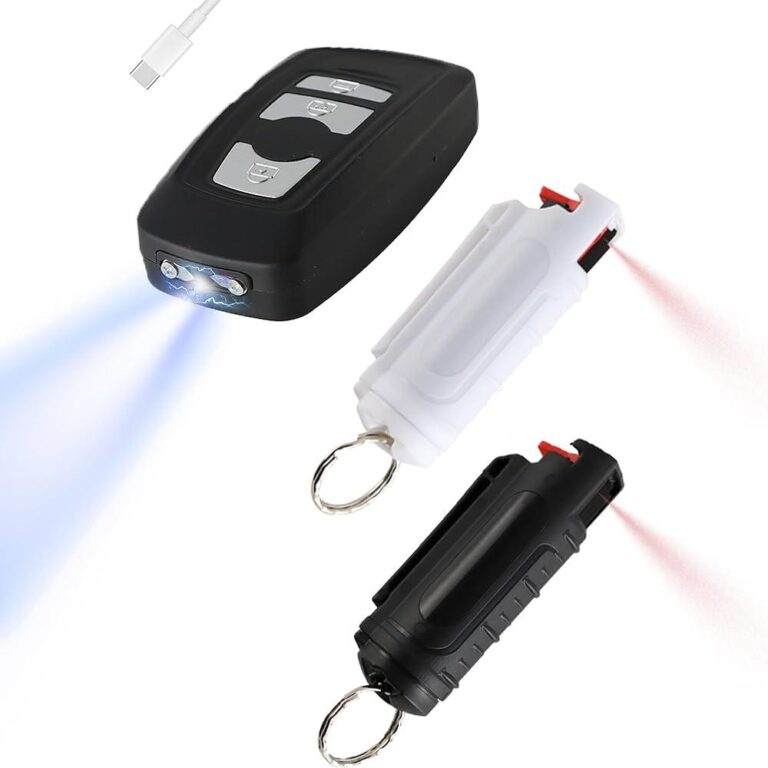Table of Contents
- Why Voltage Alone Isn’t Enough for Effective Stun Guns
- The Role of Current and Pulse Duration in Stun Gun Performance
- How Waveform and Frequency Impact Stun Gun Efficiency
- Best Practices for Choosing a Stun Gun with Optimal Electrical Specifications
- Closing Remarks
Why Voltage Alone Isn’t Enough for Effective Stun Guns
Many people assume that a stun gun’s power hinges solely on its voltage, but that’s a common misconception. While high voltage is crucial, it is only one part of a more complex mechanism. Simply put, voltage is the force that pushes an electrical current through a target’s body, but without sufficient current, the shock won’t effectively disrupt muscle and nerve functions. This balance ensures the stun gun is not just intimidating on paper but genuinely incapacitating when used.
Several other factors empower stun guns beyond just voltage:
- Current strength: The measured amperage determines how much electrical energy actually passes through the target, impacting effectiveness and safety.
- Pulse frequency: The rate at which electric pulses are delivered influences how muscles respond and become temporarily immobilized.
- Duration of shock: Longer exposure can intensify the effect but also requires careful design to avoid permanent injury.
Combining these elements creates a controlled, powerful shock that can incapacitate without causing lasting harm, making effective stun guns more scientifically sophisticated than the simple voltage ratings suggest.
The Role of Current and Pulse Duration in Stun Gun Performance
While many people tend to focus on the voltage rating of stun guns, the current and the duration of each electrical pulse are equally critical factors that determine their effectiveness. Voltage alone doesn’t cause muscle incapacitation; it’s the flow of electrical current disrupting the body’s neuromuscular system that creates the stunning effect. The current must be strong enough to override your body’s natural electrical signals to muscles, but delivered in carefully timed pulses to prevent permanent damage. Short bursts of current allow the stun gun to disable the target efficiently without causing lasting harm.
Additionally, pulse duration plays a crucial role in balancing power and safety. Typical stun guns emit rapid pulses rather than a continuous current, which helps to:
- Reduce the risk of burns or injury by limiting sustained current flow.
- Enhance muscular disruption by delivering bursts that interfere with the nervous system in quick succession.
- Optimize battery life since pulsed discharges consume less energy than continuous streams.
How Waveform and Frequency Impact Stun Gun Efficiency
The effectiveness of a stun gun hinges not only on delivering high voltage but also on the specific waveform and frequency of the electric pulse it generates. Different waveforms influence how the electrical energy interacts with the body’s nervous system. For instance, a pulsed waveform can disrupt muscle control more efficiently than a continuous one by causing rapid, repetitive nerve stimulation. Meanwhile, the frequency-the number of electrical pulses delivered per second-plays a critical role in determining the level of neuromuscular incapacitation. A well-tuned frequency ensures the current disrupts voluntary muscle movements without allowing the body to adjust or recover between pulses.
When designing stun guns, manufacturers consider several key factors related to electric pulses to maximize impact without increasing danger unnecessarily. These include:
- Pulse Duration: Short bursts are more effective in shocking muscles without causing permanent harm.
- Frequency Range: A balance between low and high frequencies helps maintain control over involuntary muscle contractions.
- Waveform Shape: Square or exponential decay pulses have different physiological effects and comfort levels.
By optimizing these elements rather than simply aiming for higher voltage, stun guns achieve a safer and more dependable means of temporary incapacitation.
Best Practices for Choosing a Stun Gun with Optimal Electrical Specifications
When selecting a stun gun, focusing solely on the voltage rating is a common yet misguided approach. Although high voltage can deliver a strong initial shock, it doesn’t guarantee effectiveness without considering other critical electrical factors. Current (measured in milliamps) is equally important, as it determines the actual energy penetrating the body’s resistance and disrupting nerve transmissions. Additionally, pulse duration and frequency influence the stun gun’s ability to incapacitate an attacker efficiently. Devices that combine a balanced interplay of voltage, current, and pulse characteristics provide a more reliable and humane method of self-defense.
To make an informed choice, consider these essentials:
- Pulse Frequency: Higher frequencies can cause muscle spasms more effectively without prolonging pain.
- Current Output: Look for devices with sufficient current to overcome insulation like thick clothing.
- Battery Quality: A strong battery ensures stable electrical performance throughout use.
- Safety Features: Select stun guns with built-in safeties to prevent accidental discharge.
Closing Remarks
In conclusion, stun guns rely on a carefully engineered combination of factors beyond just high voltage to effectively incapacitate a target. From delivering precise electrical pulses to exploiting the body’s natural response to electric currents, these devices harness a blend of electrical principles and safety considerations to maximize their impact while minimizing lasting harm. Understanding this complexity not only highlights the sophistication behind stun gun technology but also underscores the importance of responsible use and ongoing innovation in the field of non-lethal self-defense tools. Whether you’re curious about the science or considering personal protection options, recognizing why stun guns use more than just voltage offers valuable insight into how modern safety devices truly work.Check Our Other Blogs
- StunGun – Your Trusted Source for Stun Guns, Laws, and Self-Defense Tips
- PepperSprayLaws – Your Trusted Resource for Pepper Spray Information
- StunGunLaws – Your Trusted Guide to Stun Gun Legality and Safety





